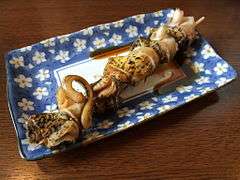Whelk

Whelk is a common name that is applied to various kinds of sea snail.[1] Although a number of whelks are relatively large and are in the family Buccinidae (the true whelks), the word whelk is also applied to some other marine gastropod mollusc species within several families of sea snails that are not very closely related.
Many have historically been used, or are still used, by humans and other animals for food. (In an average whelk (100g), there are 137 calories, 24g of protein, 0.34g of fat, and 8g of carbs.[2])
Whelks were also used in antiquity to make a rich red dye that actually improves in colour as it ages.[3]
True whelks are carnivorous, feeding on worms, crustaceans, mussels and other molluscs, drilling holes through shells to gain access to the soft tissues. Whelks use chemoreceptors to locate their prey. [4]
Usage
The common name "whelk" is also spelled welk or even wilk.
The species, genera and families referred to by this common name vary a great deal from one geographic area to another.
USA
In the United States, whelk refers to several large edible species in the genera Busycon and Busycotypus, which are now classified in the family Buccinidae. These are sometimes called Busycon whelks.
In addition, the unrelated invasive murex Rapana venosa is referred to as the Veined rapa whelk or Asian rapa whelk in the family Muricidae.
British Isles, Belgium, Netherlands
In the British Isles, Belgium and the Netherlands, the word is used for a number of species in the family Buccinidae, especially Buccinum undatum, an edible European and Northern Atlantic species.
In the British Isles, the common name "dog whelk" is used for Nucella lapillus (family Muricidae) and for Nassarius species (family Nassariidae).
Scotland
In Scotland, the word "whelk" is also used to mean the periwinkle (Littorina littorea), family Littorinidae.[5]
West Indies
In the English-speaking islands of the West Indies, the word whelks or wilks (this word is both singular and plural) is applied to a large edible top shell, Cittarium pica, also known as the magpie or West Indian top shell, family Trochidae.
Asia

In Japan, whelks are frequently used in sashimi and sushi. In Vietnam, they are served in a dish called Bún ốc - vermicelli with sea snails.
In Korea, whelks are served with chili sauce in a salad with cold noodles. It is called ""Gol Baeng-ee Mu-Chim"(골뱅이 무침). Koreans often eat it as a kind of side dish when they drink alcohol and it has been a very popular side dish with alcohol for many generations.
Australia, New Zealand
In Australia and New Zealand, species of the genus Cabestana (family Ranellidae) are called predatory whelks, and species of Penion (family Buccinidae) are called siphon whelks.
Some common examples
- Channeled whelk
- Common whelk
- Knobbed whelk, the state shell of Georgia and New Jersey
- Lightning whelk
- Red whelk
- Speckled whelk
- "Triton whelk", an Australian common name for Charonia species
- "Wrinkled whelk", a common name for both Neptunea lyrata and Nucella lamellosa
See also
| Look up whelk in Wiktionary, the free dictionary. |
- Conch, another common name used for a wide variety of large sea snails or their shells
References
- ↑ "Identify This...Conchs and Whelks - Reefland.com". www.reefland.com.
- ↑ "Nutrition and Calories in Whelk". recipeofhealth.com.
- ↑ Bede's Ecclesiastical History of England by Saint the Venerable Bede (Book 1, Chapter 1).
- ↑ "Snails and Slugs (Gastropoda)". www.molluscs.at.
- ↑ Multilingual Dictionary of Fish and Fish Products, prepared by the OECD, Paris, second edition, 1978
External links
| Wikisource has the text of the 1905 New International Encyclopedia article Whelk. |
